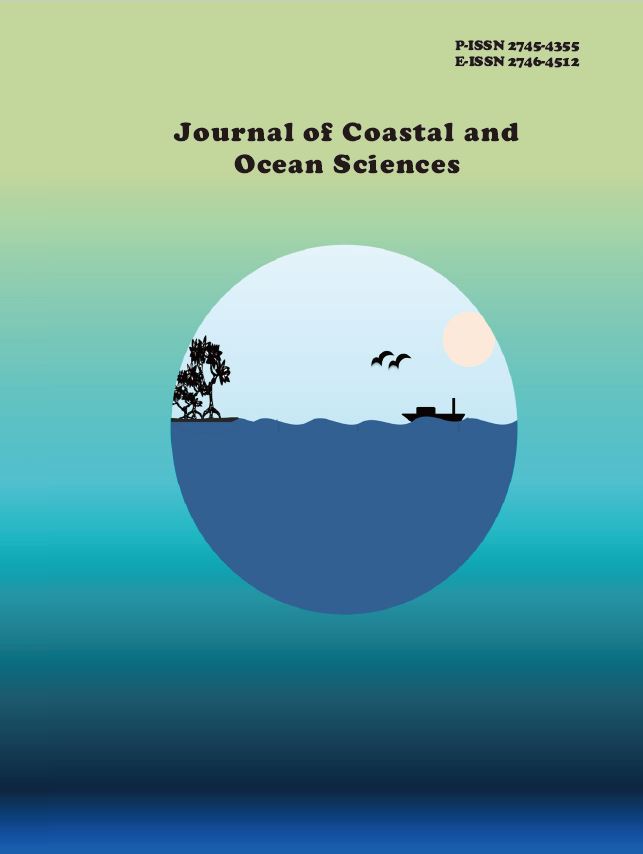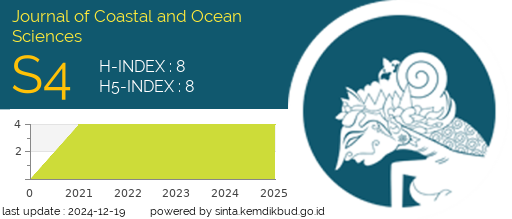Relation Macrozoobenthos with Sediment Organic Material in the Intertidal Zone in Selat Baru Beach, Bengkalis Regency, Riau Province
DOI:
https://doi.org/10.31258/Keywords:
Macrozoobenthos Organic Matter Sediment Abundance Selat Baru BeachAbstract
Selat Baru Village was one of several beaches on Bengkalis Island which was located in the northern part of Bengkalis Island. Selat Baru Beach is a tourist spot that has the most visitors every day, especially during the Eid holidays. In addition, there are rivers, ports, and boat crossings also taking place on Selat Baru Beach. The purpose of this study was to determine the content of sediment organic matter, the type and abundance of macrozoobenthos, and to determine the relationship between the organic matter of sediment and the abundance of macrozoobenthos in the New Strait coastal waters. The method used was a survey method, where the data collected was primary data which was then analyzed statistically and discussed descriptively. The results of measurements of oceanographic parameters from the research location have an average temperature of 28,67 oC, and pH of 7, a salinity of 26,33 ‰, transparency of 24,33 cm, and a current velocity of 0,1 m/s. The average sediment content obtained at station 1 was 1,42%, station 2 was 0,77%, and station 3 was 7,34%. The percentage of sand fraction has the highest percentage at station 1 substation 3 (95,56%) and the lowest at station 3 substation 3 (39,78%), while the highest percentage of mud fraction was at station 3 substation 3 (54,19%) and the lowest found at station 2 substation 1 (4,15%). The macrozoobenthos found were from the Bivalvia class (Corbicula sp, Lucinidae sp, Anomia sp) and the Gastropod class (Nucella sp, Rabdotus sp, Cerithidea sp) and the Malacostraca class (Hermigrapsus sp). The average abundance of macrozoobenthos found at station 1 was 4,22 ind/m2, station 2 was 4,22 ind/m2, and station 3 was 10,67 ind/m2. The result shows the effect of the sludge sediment fraction on the abundance of macrozoobenthos has a coefficient of determination (R2) with a value of 0,9015 and a correlation coefficient (r) with a value of 0,9495 meaning that 90,15% of macrozoobenthos abundance was influenced by sediment fraction and the rest was influenced by other environmental factors
Downloads
References
Amin, B., I, Nurrachmi dan Marwan. (2012). Kandungan Bahan Organik Sedimen dan Kelimpahan Makrozoobentos sebagai Indikator Pencemaran Perairan Pantai Tanjung Uban Kepulauan Riau. Prosiding Seminar Hasil Penelitian Dosen di Lembaga Penelitian Universitas Riau Tanggal 10 Desember 2012. Universitas Riau, Pekanbaru.
Choirudin, I. R., Supardjo, M. N. dan R. Muskananfola. (2014). Studi Hubungan Kandungan Bahan Organik Sedimen dengan Kelimpahan Makrozoobentos di Muara Sungai Wedung Kabupaten Demak. Diponegoro Journal of Maquares, 3(3): 168-176.
Darmono. (2001). Logam dalam Sistem Biologi Makhluk Hidup. Jakarta. UI Press
Edward dan M.S. Tarigan. (2003). Pengaruh Musim Terhadap Fluktuasi Kandungan Fosfat dan Nitrat di Laut Banda. Makala Sains, 7(2) : 82-89
Gultom, C.R., M.R. Muskananfola, P.W. Purnomo. (2018). Hubungan Kelimpahan Makrozoobenthos dengan Bahan Organik dan Tekstur Sedimen di Kawasan Mangrove di Desa Bedono Kecamatan Sayung Kabupaten Demak. Journal of Maquares. 7(2) : 172-179.
Gurning, M., S. Nedi, dan A. Tanjung. (2019). Sediment Organic Matter and Macrozoobenthos Abudance in Waters of Purnama Dumai. Asian Journal of Aquatic Sciences, 2(3): 214-223
Hawari, A., B. Amin dan Efriyeldi. (2013). Hubungan Antara Bahan Organik Sedimen dengan Kelimpahan Makrozoobenthos di Perairan Pantai Pandan Provinsi Sumatera Utara. Jurnal Online Mahasiswa (JOM) Bidang Perikanan dan Ilmu Kelautan, 1(2): 1-11.
Makri. (2018). Struktur Komunitas dan Kelimpahan Makrozoobentos di Danau Ranau Oku Selatan Sumatera Selatan. Jurnal Ilmu-ilmu Perikanan dan Budidaya Perairan, 13(1): 9-13.
Pett, R.J. (1993). A Collection of Laboratory Mtehod for Selected Waters and Sediment Quality Parameter Report No. 13 International Development Program of Australia University an Coleges. PT. Husfarm Dian Konsultan.
Pratiwi, R. dan O. Astuti. (2012). Biodiversitas Krustasea (Decapoda, Brachyura, macrura) dari Ekspedisi Perairan Kendari 2011. Jurnal Ilmu Kelautan, 17(1): 8-14
Rifardi. (2008). Tekstur Sampling dan Analisis Sedimen. Unri Press. Pekanbaru. 101 hlm
Sinaga, T. (2009). Keanekaragaman Makrozoobenthos Sebagai Indikator Kualitas Perairan Danau Toba Balige Kabupaten Toba Samosir. Tesis. USU. 93 hlm.
Sugianto, A. (1994). Ekologi Kuantitatif. Usaha Nasional. Surabaya.
Yuniar, A.S., H. Endrawati, dan M. Zainuri. (2012). Struktur Komunitas Makrozoobentos di Perairan Morosari, Kecamatan Sayung, Kabupaten Demak. Journal of Marine Research, 1(2): 235-242.






